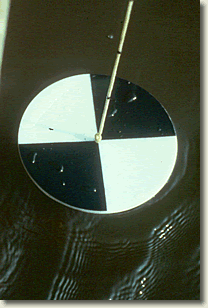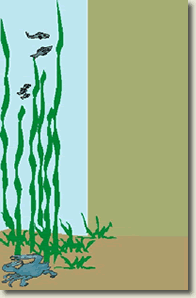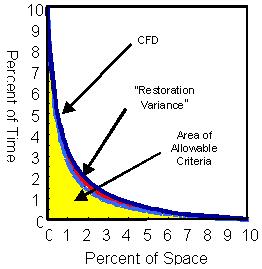Frequently Asked Questions: Chesapeake Bay Water Quality Standards
Main_Content
State and Federal laws set standards annually or seasonally to protect a water body, depending on its designated use. These standards are set by first defining the water body’s designated use, then, determining what water quality thresholds must be met in order to support the designated use.
MDE uses these standards to assure that state waterways are useable for drinking water, swimming, fishing, industrial and agriculture. These standards are used by permit writers to regulate what individuals, businesses or farms may discharge into waterways.
Designated Uses define an intended human and aquatic life objective, use, or goal for a water body. An area's designated use refers to a water body's function – such as fishing or swimming. It takes into account the attainable use of the water body for public water supply, the protection of fish, shellfish, and wildlife on a consumer level, as well for its recreational, agricultural, industrial and navigational purposes.
The Chesapeake Bay tidal waters designated uses, reflect the variety of habitats found throughout the Bay and its tidal tributaries. The Bay's fish, crabs, oysters and underwater grasses are distinguished by natural habitats that differ by salinity and depth and not artificial boundaries. This is why the states try to advocate their protection.
These five revised Chesapeake Bay tidal water designated uses more fully reflect the different water resource communities inhabiting them, and the protection of aquatic life in the tidal habitats.
| Designated Use | What is Protected | Habitats and Locations
|
1. Migratory Fish Spawning and Nursery | Migratory fish including striped bass, perch, shad, herring and sturgeon during the late winter/spring spawning and nursery season.
| In tidal freshwater to low-salinity habitats. This habitat zone is primarily found in the upper reaches of many Bay tidal rivers and creeks and the upper mainstem Chesapeake Bay.
|
2. Shallow-Water | Underwater bay grasses and the many fish and crab species that depend on this shallow-water habitat.
| Shallow waters provided by grass beds near the shoreline. |
3. Open-Water Fish and Shellfish | Water quality in the surface water habitats to protect diverse populations of sportfish, including striped bass, bluefish, mackerel and seatrout, bait fish such as menhaden and silversides, as well as the shortnose sturgeon, and endangered species.
| Species within tidal creeks, rivers, embayments and the mainstem Chesapeake Bay year-round. |
4. Deep-Water Seasonal Fish and Shellfish | The many bottom-feeding fish, crabs and oysters, and other important species such as the bay anchovy. | Living resources inhabiting the deeper transitional water column and bottom habitats between the well-mixed surface waters and the very deep channels during the summer months. The deep-water designated use recognizes that low dissolved oxygen conditions prevail during the summer due to a water density gradient (pycnocline) formed by temperature and salinity that reduces re-oxygenation of waters below the upper portion of the gradient.
|
5. Deep-Channel Seasonal Refuge | Bottom sediment-dwelling worms and small clams that act as food for bottom-feeding fish and crabs in the very deep channel in summer.
| Deep-channel designated use recognizes that low dissolved oxygen conditions prevail in the deepest portions of this habitat zone and will naturally have very low to no oxygen during the summer. |
Water quality criteria, as part of a water quality standard, express water pollutant (e.g., nutrients) or water quality parameter (e.g., dissolved oxygen) or a “free from” condition, to protect given designated uses. Quality Criteria may be expressed in numbers or narrative, to measure frequency (how often), magnitude (size of offense), and duration (length of time). Meeting these criteria strives for a quality of water that supports and protects each designated use.
Resources
Dissolved Oxygen
Fish and other aquatic life require levels of dissolved oxygen to survive. Seasonal algae blooms deplete dissolved oxygen, and may render deep waters of the Bay uninhabitable to certain species. It affects species such as the endangered Atlantic Sturgeon during certain times of the year. Required Bay dissolved oxygen levels should be set by the communities inhabiting the Bay at different times of the year. Natural conditions will dictate how to apply seasonal dissolved oxygen criteria by designated use.
| Designated Use | Criteria | Temporal Application
|
| Migratory Fish Spawning and Nursery | 7 day mean >= 6 mg liter-¹ (1)
Instantaneous minimum >= 5 mg liter-¹
| February 1 - May 31 |
| Open-Water Fish and Shellfish¹ ² | 30 day mean of >=5.5 mg liter-¹ in low salinity; 5 mg liter-¹ in high salinity
7 day mean of >= 4 mg liter-¹
Instantaneous minimum of >= 3.2 mg liter-¹
| Year-round |
Deep-Water Seasonal Fish and Shellfish | 30 day mean of >= 3 mg liter-¹
1 day mean of >= 2.3 mg liter-¹
Instantaneous minimum of >= 1.7 mg liter-¹
| June 1 - September 30 |
Deep-Channel Seasonal Refuge | Instantaneous minimum of >= 1 mg liter-¹ | June 1 - September 30
|
Chlorophyll a
Measurements of chlorophyll a indicate levels of phytoplankton or algal biomass in the water column. Bay chlorophyll a levels should be moderate. Levels that are too high cause harmful algal blooms that lead to poor quality food, shade the light in shallow water habitats. This results in low dissolved oxygen conditions when the algae die off and sink to the bottom.
Water Clarity
| Salinity Regime | Water Clarity Criteria as
Percent Light-through-Water | Temporal Application |
| Tidal Fresh | 13% | April-October |
| Oligohaline | 13% | April-October |
| Mesohaline | 22% | April-October |
| Polyhaline | 22% | March-May,
September-November
|

 Underwater grasses are an essential component of the Bay's living resources habitat. Decreased water clarity inhibits the growth of underwater Bay grasses. Increased sediment loads and algal biomass, spurred by excess nutrient inputs to the Bay, will impact water clarity. Bay water quality conditions should have high water clarity to allow sunlight to penetrate, and support underwater grass restoration throughout the Bay's shallow-water habitats.
Underwater grasses are an essential component of the Bay's living resources habitat. Decreased water clarity inhibits the growth of underwater Bay grasses. Increased sediment loads and algal biomass, spurred by excess nutrient inputs to the Bay, will impact water clarity. Bay water quality conditions should have high water clarity to allow sunlight to penetrate, and support underwater grass restoration throughout the Bay's shallow-water habitats.
The criteria involve SAV (Submerged Aquatic Vegetation) restoration goals (acres of standing SAV crop), or measuring water clarity criteria using a Secchi disk technique.
Resources
 A restoration variance allows dissolved oxygen criteria to slightly exceed the requirement up to 7% in a couple of the deepest areas of the Bay.
A restoration variance allows dissolved oxygen criteria to slightly exceed the requirement up to 7% in a couple of the deepest areas of the Bay.
This modification to the Bay water quality standards was necessary because in those few deep areas, we may not meet the dissolved oxygen requirements. Even after spending billions of dollars to reduce nitrogen, phosphorus, and sediment pollution to clean up the rest of the Bay, essentially doing everything we know how to do at this time, the deep areas still could not attain the dissolved oxygen standard. This is a better, more protective alternative than lowering the standard based on current understanding. The information will be updated periodically to keep the water quality standard focused on protecting living resources, rather than proposing something less protective. The State is required to review the restoration variances at least every three years (based on EPA regulations), and adjust it accordingly.
Center_Content
Contact Information
Please direct questions or comments concerning Frequently Asked Questions - Chesapeake Bay Water Quality Standards to Matthew Stover at matthew.stover@maryland.gov or 410-537-3611.
